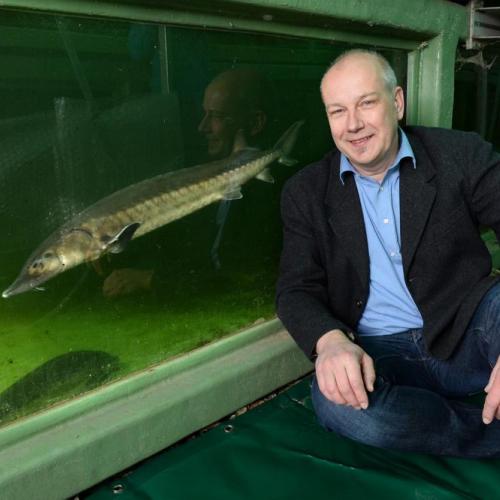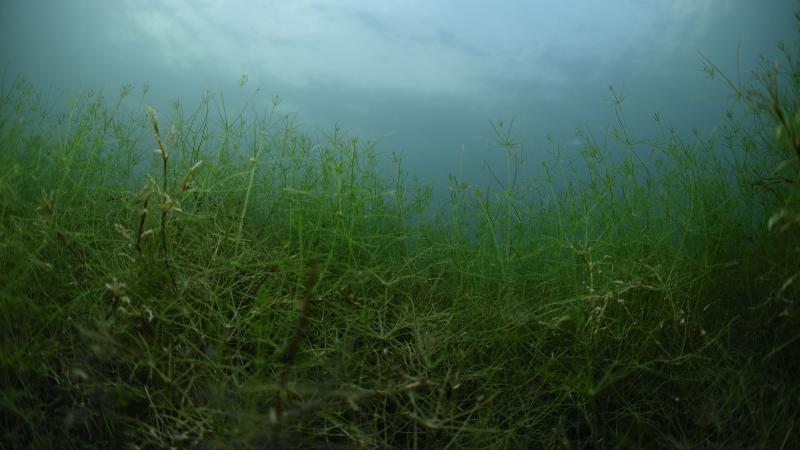Baltic sturgeon from the reintroduction programme are also severely affected by the fish kill in the Oder River. After being released into the wild (as this sturgeon in October 2021 in Lebus), the juveniles stay in the Oder for up to three years before they migrate to the Baltic Sea. Not many of them are likely to have survived. | Photo: Angelina Tittmann/IGB
It is very likely that the majority of the 1,000 and more juvenile sturgeon that were released into the river this spring have perished in the disaster. But not only that – based on current information, the fish kill has also affected individuals that were up to three years of age and up to 90 centimetres long. They were discovered in the Lower Oder Valley – migrating to the Baltic Sea, which they never reached. “It is impossible at present to make a reliable estimate of the number of sturgeon still alive in the Oder and how many have died,” stated Jörn Geßner, researcher at the Leibniz Institute of Freshwater Ecology and Inland Fisheries (IGB). But one thing is for sure: the man-made environmental disaster is a major setback for the reintroduction programme, which Geßner has been coordinating since way back in 1996.
Sturgeon perished in the river and in fish-rearing facilities
Besides killing sturgeon that had already populated the river, the toxic wave also affected two fish-rearing facilities that contained a total of around 20,000 juvenile sturgeon. Virtually none of the sturgeon being reared there survived the incident. “The fish that perished were only one month old, and they were supposed to be released into the Oder River in autumn to help establish a self-sustaining stock of sturgeon there in the future,” the biologist explained. To make sure the fish get accustomed to their future habitat and its normal water conditions, and one day find their way to their natural spawning grounds, both facilities are fed with river water. As a result, they were hit by the toxic wave on 10 and 11 August. “Had the Polish authorities issued an early warning, the fish could probably have been saved,” criticised Geßner.
Since 2007, he and several partners have released some 3.5 million juveniles into the Oder. It takes a long time before the fish are mature enough to produce their own offspring. Aged one to three years, the fish migrate to the Baltic Sea and grow there, only returning to their home river to spawn when they are 14 to 16 years old. It is therefore likely that the larger and older individuals in the Baltic Sea have survived the disaster. “Our hope now is that only a small proportion of the fish in the entire programme have been affected,” stated Jörn Geßner. Smaller fish in particular sometimes also inhabit the branches of the Międzyodrze region, where they may have survived. Particularly in the Szczecin Lagoon, which has so far been spared from the fish kill, there are likely to be juveniles in search of food.
Uncertain future for the reintroduction programme
However, it is unclear when restocking measures can resume in the reintroduction programme on the Oder. Even if the algal bloom continues to decrease, the residues of the toxin still have to be degraded or discharged before restocking is possible. It is also uncertain whether juveniles will be able to find sufficient food. After all, not only fish have been hit particularly hard, but also the river’s snail and mussel populations, among other things. The extent to which other aquatic invertebrates have been affected remains unclear. This is why a lot now depends on how quickly the ecosystem recovers. To determine this rate of recovery, Jörn Geßner and colleagues at IGB would like to conduct intensive on-site investigations at the earliest possible opportunity. If it turns out that there is insufficient food in the river or that the water is still too polluted, no more sturgeon would be released into the wild this year. This would mean that the remaining juvenile sturgeon would have to be kept in fish tanks until next spring at least. But those tanks are needed to rear the next generation of sturgeon over the winter. This could lead to space constraints.
How the ecosystem and stocks can recover
In the medium term, it is particularly important to increase the availability of spawning and brood-rearing habitats in the Oder River. This would provide the sturgeon – and hence many other typical freshwater fish species – with better starting conditions for successful self-reproduction, which would stabilise stocks. “Many of these fish species native to the Oder spawn on gravel. If there were more gravel areas, the recovery process would be quicker,” explained IGB researcher Christian Wolter, who has been investigating fish communities in the Oder for years. After all, fish generally have a high reproductive potential and are also able to recover relatively quickly from such disasters if the framework conditions allow it. Providing fish with such aids would enable their swift recovery.
In the long term, more backwaters would have to be connected to the river to create refuges. Jörn Geßner and Christian Wolter therefore agree that restoration is the best way to prevent crises. The river needs to be better connected to its tributaries, and the floodplains require more natural water retention to ensure that the river holds more water over the course of the year. Intact floodplains do not only act as water reservoirs, they also provide natural flood protection. However, the Polish government’s Oder development project is diametrically opposed to this – and in 2015, Germany also committed to implementing river engineering measures on the Oder River in a bilateral agreement. Thus, the researchers recommend putting an immediate stop to anything that may add additional stressors to the river and its species communities – especially the current dredging work on the Polish side, which could, among other things, cause toxic contaminants from the sediment to make their way into the river water. Due to such major interventions, the Oder is losing its resilience, i.e. its natural capacity to recover. “As a result of climate change, extreme weather conditions become more common, while the human use of water resources continues to increase. If aquatic ecosystems and their organisms are to cope with these circumstances, they must be sufficiently resilient — something that can only be achieved by significantly increasing the diversity of the structure of water bodies and species communities, and not by technical solutions alone,” emphasised Wolter.
A glimmer of hope – but not for all species
Sturgeons have one major advantage: they can live up to 100 years, and sometimes even longer – as long as they are not disturbed. Other endangered species such as the Atlantic salmon, the Maraena Whitefish and the Baltic golden loach are unable to span such long periods. This is also true for typical freshwater fish species such as barbel, nase and vimba bream, and for numerous rare species of large mussels and insects. Some can, or could, only be found in the Oder River, one such example being the Golden loach. “These endangered species are now doubly threatened: not only by the wave of poison, but also by the pressures caused by the development of the Oder and all existing and future pressures,” remarked Christian Wolter. There are even fears that the only population of the Baltic golden loach in Germany has not survived the disaster. Extensive dredging and groyne construction work was undertaken in the core area of the small population on the Polish bank near Reitwein, in spite of low water levels and high temperatures. These operations alone would have significantly impacted the habitat of the Sabanejewia baltica, even before the toxic wave hit the area. After the toxic wave has subsided, it will be necessary to find out whether the animals can still be found in their habitat.
While the sturgeon will continue to be dependent on restocking measures within the reintroduction programme that are scientifically well justified and monitored, Christian Wolter strongly advises against such action for other freshwater fish species: “The Maraena Whitefish population in the River Oder, for example, is unique, and also the Oder’s minnow and chub specimens are distinct species or genetic units that could be wiped out if stocks are introduced from other areas.” Especially when populations are low after such a fish kill event, stocking with non-native fish could result in the loss of genetic identity of fish from the Oder.
Read the Polish version of the text >
Polskie tłumaczenie tekstu można znaleźć tutaj >
~
IGB has been researching and working on the Oder for decades, especially on river ecology and fish communities. In addition, the institute coordinates the reintroduction programme of the Baltic sturgeon in the river basin. Therefore, researchers wanted to find out what caused sturgeon and other animals to die in the Oder and followed the trail of a strong toxin that can be produced by the algae species Prymnesium parvum. They were already able to detect this alga and its toxin in masses in water samples from the Oder. Such a mass development is not a natural but a human-caused phenomenon, probably boosted by salt discharges, copious amounts of nutrients, high water temperatures, and long residence times in barrages.





